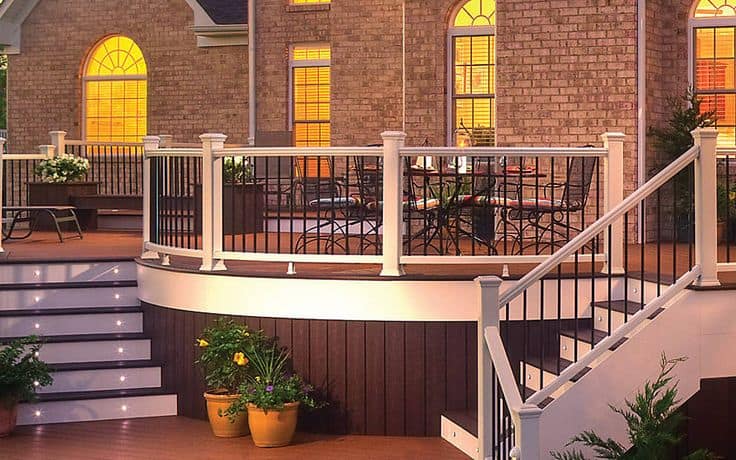
Do I Need Railing On My Deck?
If your deck is somewhat low to the ground, you may have chosen not to install a railing. Unfortunately, this choice isn’t always wise due to safety concerns, as well as code violations.
In this blog, we’ll explore the reasons why it is in one’s best interest to install a railing and the decking codes to follow.
Decking Codes
If your deck is below 30 inches, a railing is not required.
With that said, if you choose to build a deck, even if it is only 24 inches off the ground, that is still high enough that even an adult could injure themselves. When you take your kids and pets into account, the risk is even higher.
Reasons People Decide Not to Install a Railing
Building a deck is not an inexpensive decision, so when someone is tasked with the decision to spend extra money on something they “don’t need,” like a deck railing, the choice seems obvious: save money.
There’s also the aesthetic factor of not having a railing. For some, the look of uninterrupted deck space is what they want.
In addition, some people feel railings are difficult to install because their decks are an unusual shape. This shouldn’t be a concern, though. There are some great, easy-to-install railing kits available for decks with unorthodox shapes.
Why You Should Install a Railing
As previously mentioned, safety is the biggest concern when it comes to deciding whether or not to install a railing.
Railings can serve to protect children, pets, and even adults. It may seem like a short distance, but any fall can lead to broken bones or other injuries. Rather than being ever-vigilant when the kids are horsing around on the deck, deck railing helps give you peace of mind so you can relax and enjoy the view.
Taking away the safety aspect and just focusing on aesthetics, a railing can make your deck look much more expensive without adding a large sum to the grand total. Check out the large variety of railings available at Decks & Docks and add that finishing touch to your deck today.
What to Do if there Are No Requirements
Let’s say you have a deck that’s below 30 inches and there are no guardrail requirements by the IRC (International Residential Code). You could take the chance and go against the recommendations by the individual railing manufacturers. Keep in mind, if you do this as a contractor and someone hurts themselves due to faulty railing installation, they will be favored by a judge if they decide to sue. Ultimately, it’s always best to follow the manufacturer’s recommendations instead of cutting corners. Also keep in mind that there are deck railing height requirements, The IRC requires guardrails to be at least 36″ in height measured from the deck surface to the top of the rail.
There are deck railings that exist just to be decorative but which don’t serve a functional purpose. These aren’t the best idea because they aren’t truly functional. As previously mentioned, if you install a railing and someone gets hurt because it’s faulty, a lawsuit will most likely not go in your favor.
Codes to Keep in Mind
According to decks.com, a site maintained by Trex, your deck will be required to pass these tests during an inspection.
Uniform Load Test: The top rail of your deck must be able to withstand at least 125 lbs of force (applied vertically or horizontally).
Infill Load Test: This measures the strength of spindles, balusters, or any other load-bearing element between posts. An area of one-square-foot must be able to resist a force of 125 lbs.
Concentrated Load Test: The deck’s top rail must hold a point load of 200 lbs applied at three points: the mid-span, adjacent to a post, and on top of a post.
Types of Railings
Whether you want a modern, industrial, or traditional railing to enhance the look of your deck, Decks & Docks has something for you (plus everything you need to install it).
There are five types of railings—vinyl, cable, stainless, composite, and metal—and they each have their own benefits and style.
- Cable railing is great for those looking for a chic railing for their deck, as well as a railing that will not hinder any views. They’re versatile and can be used on decks, docks, and even interior spaces for a clean, utilitarian look.
- Stainless steel gives any deck a super sleek look. Some homeowners and builders expect stainless steel to be expensive, but it’s surprising how affordable it can be. Plus, stainless steel is made to withstand the test of time, making it a more durable and cost-effective choice in the long run.
- Aluminum railing is designed for those who like versatility and durability. With a variety of textures and colors available, you can find an option that truly exemplifies the style of your home. These railings arrive pre-assembled so you can enjoy them as soon as possible.
- Composite railing is the closest one can get to the look of real wood without the hassle of having to paint and stain and worry about splinters. It’s ideal for someone looking for a traditional look with less maintenance. Plus, composite railing is long-lasting.
- Vinyl is a great choice for those looking for a low maintenance railing. It comes in many colors to match a new or already existing deck. Vinyl doesn’t show scratches like wood and doesn’t need to be painted like traditional wood decks. Vinyl’s durability makes it a cost-effective solution in the long run. It also provides a more traditional look for someone who’s going for classic deck design.
Decks & Docks is here for all of your decking and railing related needs. Call our friendly staff with any questions at 866-528-9663 and check out our gallery for inspiration.
